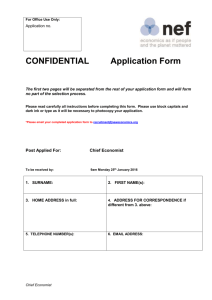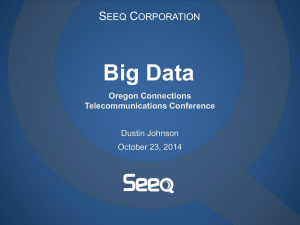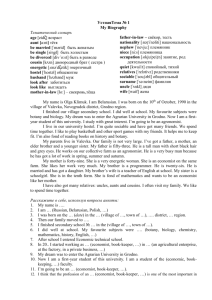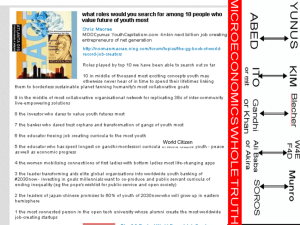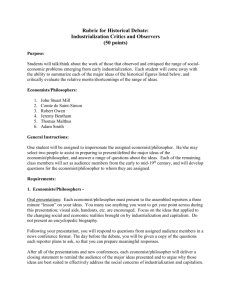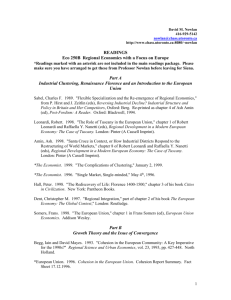Syllabus - Brandeis University
advertisement
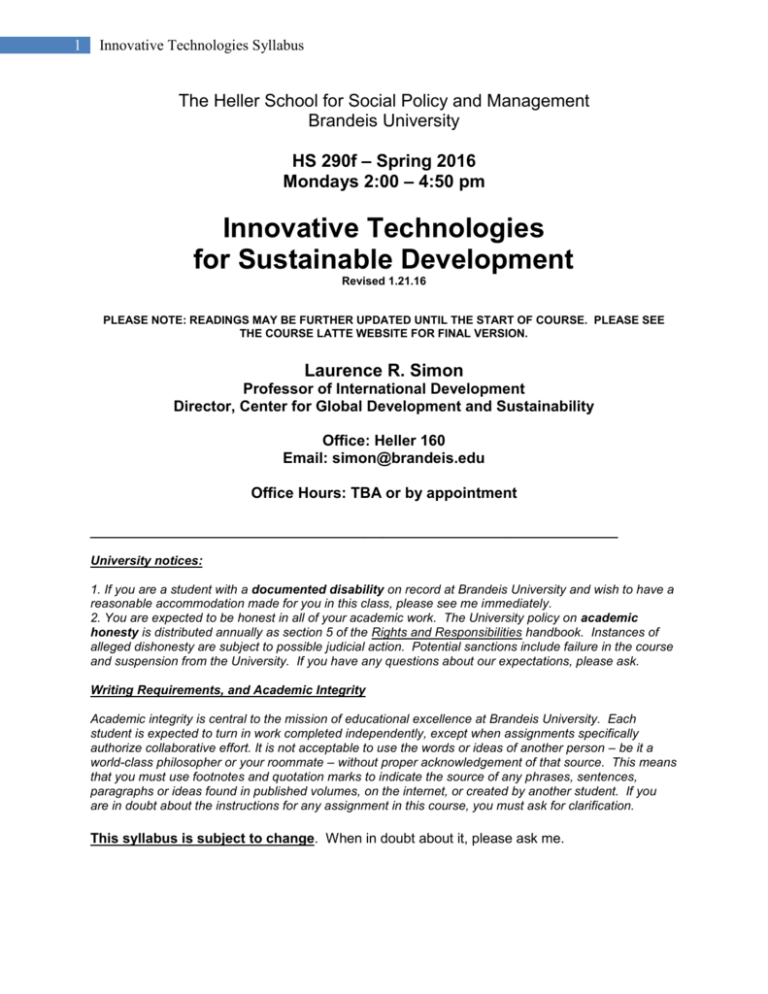
1 Innovative Technologies Syllabus The Heller School for Social Policy and Management Brandeis University HS 290f – Spring 2016 Mondays 2:00 – 4:50 pm Innovative Technologies for Sustainable Development Revised 1.21.16 PLEASE NOTE: READINGS MAY BE FURTHER UPDATED UNTIL THE START OF COURSE. PLEASE SEE THE COURSE LATTE WEBSITE FOR FINAL VERSION. Laurence R. Simon Professor of International Development Director, Center for Global Development and Sustainability Office: Heller 160 Email: simon@brandeis.edu Office Hours: TBA or by appointment ______________________________________________________ University notices: 1. If you are a student with a documented disability on record at Brandeis University and wish to have a reasonable accommodation made for you in this class, please see me immediately. 2. You are expected to be honest in all of your academic work. The University policy on academic honesty is distributed annually as section 5 of the Rights and Responsibilities handbook. Instances of alleged dishonesty are subject to possible judicial action. Potential sanctions include failure in the course and suspension from the University. If you have any questions about our expectations, please ask. Writing Requirements, and Academic Integrity Academic integrity is central to the mission of educational excellence at Brandeis University. Each student is expected to turn in work completed independently, except when assignments specifically authorize collaborative effort. It is not acceptable to use the words or ideas of another person – be it a world-class philosopher or your roommate – without proper acknowledgement of that source. This means that you must use footnotes and quotation marks to indicate the source of any phrases, sentences, paragraphs or ideas found in published volumes, on the internet, or created by another student. If you are in doubt about the instructions for any assignment in this course, you must ask for clarification. This syllabus is subject to change. When in doubt about it, please ask me. 2 Innovative Technologies Syllabus This is a fast-paced course reviewing many technologies for their benefits to sustainable development, environmental protection and poverty reduction. Course readings are mostly non-scholarly, non-technical and very accessible introductions to technology and technology transfer. The course is taught through a problem-solving approach to problems of development and health. Basis of Course Grade Class attendance and participation (10% of final course grade) Class preparation evaluated by quizzes: (25%). Individual or group presentation to class on selected case studies or topics. (20%): Depending on the size of the class, students will investigate issues of technology transfer or assess specific technologies and report their findings to the class. Additionally, students will volunteer to prepare “nuts and bolts” background briefings (no more than 5 minutes each) on key issues and institutions that seem to be a gap in class knowledge (e.g. what are the new U.N. Sustainable Development Goals, what is the Consultative Group on International Agricultural Research; what is a UNESCO World Heritage Site?) Case study research paper on sustainable technology strategies, policies and impacts in one selected country (see grade percentages below for each element of this project). Each student will choose a country of interest for this case study. Drawing from research on the selected country and from course readings and discussions, students should: begin with an abstract of the paper; summarize the history of technology transfer to and/or technological innovation in that country; summarize the scope and trend of technology programs in a development sector (e.g. agriculture, health, energy etc.) being planned or implemented; then focus on a gap in one sector and write a plan for the development or transfer of a sustainable development technology discussing in detail the technology and the needed institutions, partners, policies, trial and adoption strategies to be employed; develop a framework for evaluating the efficacy of the technology, its cultural, social, environmental and economic impacts on users and other stakeholders; This case study project will have several elements graded separately: Proposal (5%): To begin the preparation for the paper, you will submit a brief proposal of approximately 400-words that defines the technology being addressed, provides a summary overview of development sector in which the technology will be used, and a preliminary outline for the study. Submission of written proposals and the related presentations will be expected and presented during the third or fourth class. Proposals need to be approved by me. I encourage you to meet with me to discuss your ideas. Paper (30%): The paper should not exceed 2500 words (exclusive of bibliography / references) and should be formatted using 1.5 spacing. The paper is due by 11 p.m. on the date of the final class session. All papers should be uploaded to the Latte course website. Late papers will not be accepted except for medical reasons or family emergency. I am available to discuss your paper with you at any time during your research. Presentation of final paper (10%): You will give a presentation of your case study during the final class sessions. The presentation length will be determined after the number of students enrolled is clear. 3 Innovative Technologies Syllabus Course Description Innovative Technologies for Sustainable Development Course Rationale The Oxford English Dictionary defines technology as the application of scientific knowledge for practical purposes; a branch of knowledge dealing with engineering or applied sciences. Development has sought to use technology to enhance economic development, agricultural productivity, public health, generation of energy, education and other development objectives. The concept of appropriate technology for development began in the 1960s as tools that could be used at the village with minimal training and made of mostly locally gathered materials. Today many villagers in Africa have more computing power in their smartphones than guided the first manned spacecraft to the moon. Appropriate technology today involves bringing science to the people to meet critical needs for development by local NGOs, private sector, local and national governments. The best practices for technology transfer, however, are still largely unknown or ignored by both sellers and users. This course reviews the history of technology transfer and new or emerging innovative technologies are assessed for their potential contribution and positive or negative consequences for sustainable economic, social and human development. Technology transfer strategies are reviewed for their approach as peoplecentered within an empowerment, choice framework (see below reference for Dorothea Klein, Technologies of Choice.) The Innovative Technologies course has four broad goals: (1) To provide an over-arching framework for understanding technology transfer including through non-profit and private sector efforts. (2) To introduce and assess innovative technologies for their potential contribution to sustainable and equitable development in low and middle income countries; (3) To consider technology transfer as a component of aid effectiveness and to examine technology transfer programs for their motivations, objectives and interests. (4) To enable students to gain the skills needed to evaluate proposals for the utilization of new technologies and their impacts. Students will have an opportunity to learn about the work of the iLab at the Center for Global Development and Sustainability (GDS) and to become involved in briefings and dissemination of GDS technological models and strategies. Invited guest speakers (to be confirmed) include: Calestous Juma, Professor of the Practice of International Development and Director of the Science, Technology, and Globalization Project at the Belfer Center for Science and International Affairs, Harvard University; Sajed Kamal, renewable energy specialist, Solar Fenway and associate, BRAC – Bangladesh; Naeem Saleem, M.D., Public health specialist, Pakistan. Heller School PhD candidate. 4 Innovative Technologies Syllabus Session 1: Monday March 14, 2016 Course Introduction Course overview: objectives, requirements; course content. The role of technological innovation in world development The building of technological capacity Gender and technology Technological leapfrogging A survey of technologies for course study Readings Diamond, Jared. (1999) Farmer Power: The roots of guns, germs, and steel. In Guns, Germs, and Steel: The Fates of Human Societies. New York: W.W. Norton. Diamond, Jared. (1999) Necessity’s Mother: The evolution of technology. In Guns, Germs, and Steel: The Fates of Human Societies. New York: W.W. Norton. Gill, Rosalind and Keith Grint. (1995) The Gender-Technology Relation: Contemporary Theory and Research. In The Gender-Technology Relation: Contemporary Theory and Research. London: Taylor & Francis. Morris, Ian. (2010) Before East and West. In Why the West Rules – For Now: The Patterns of History, and What They Reveal About the Future. New York: Farrar, Straus and Giroux. Session 2: Monday March 21 Part I Domination of nature or sustainable development? Evolution of concepts of technology for poverty reduction Readings Ali, Saleem H. (2009) The Rush Factor: Tracing the Mineral Roots of Global Power Through Gold, Coal, and Oil. In Treasures of the Earth: Need, Greed, and a Sustainable Future. New Haven: Yale University Press. Williams, Robin and David Edge. (1996) “The social shaping of technology,” Research Policy, Vol. 21 (1996), pp. 865-899. Easterly, William. (2013) Technology: How to Succeed Without Knowing How. In The Tyranny of Experts: Economists, Dictators, and The Forgotten Rights of the Poor. New York: Basic Books. Part II Introducing principles of technology transfer Readings 5 Innovative Technologies Syllabus Simon, Laurence (2015) Ten Principles of Technology Transfer for Sustainable Development. (Innovative Technology Working Paper #1). Waltham, MA: The Center for Global Development and Sustainability. To be published January 2016. Part III Introducing innovative technologies in food and agriculture Green Revolutions 1 and 2: Traditional seed, landlessness and pesticide poisonings as collateral damage Introduction to innovative post-harvest technologies Introduction of drones and sensor networks for small farmer and extension service crop and storage inspection Plant based meat substitutes Introduction to agricultural biotechnologies From selective breeding to genetic engineering The controversy over Genetically Modified Organisms Readings / Media International Rice Research Institute. Rice Knowledge Bank. Storage: http://www.knowledgebank.irri.org/step-by-step-production/postharvest/storage, and http://www.knowledgebank.irri.org/step-by-step-production/postharvest/storage/cocoon Bern Carl J., et. al. (2013) Hermetic storage systems for maize stored on subsistence farms. Agricultural and Biosystems Engineering. Paper Number: 131591815. Ames: Iowa State University. Walsh, S., D. Baributsa, T. Remington and L. Sperling. (2014). Seed Storage Brief #2: Hermetic Seed Storage Technology: Principles, Use, and Economics – a Practitioner’s Guide. Nairobi: Catholic Relief Services. Harmon, Amy (2013, August 24). Golden Rice: Lifesaver? The New York Times. Retrieved from http://www.nytimes.com/ Grandia, Liza (2014). Modified landscapes: vulnerabilities to genetically modified corn in northern Guatemala. In The Journal of Peasant Studies. 41(1): 79-105. Familiarize yourself with the following technology news Beetles and bugs: Protecting coffee crops (2015, July 18). The Economist, p 68. Also available online http://www.economist.com/ Silicon Valley gets a taste for food (2015, March 7). The Economist, pp13-15. Also available online http://www.economist.com/ Jacobson, Rowan (2014). Has Meat Met its Match? In Ensia, pp. 8-15. Minneapolis: University of Minnesota. Field research (2014, November 8). The Economist, p. 82. Also available online http://www.economist.com/ 6 Innovative Technologies Syllabus The Robot overhead: Civilian drones (2014, December 6). The Economist, pp. 11-12. Also available online http://www.economist.com/ 7 Innovative Technologies Syllabus Session 3: Monday April 4 Innovative technologies in food and agriculture continued Indoor hydroponic, LED farming Emergency storage in humanitarian operations Pesticides and Acute Kidney Syndrome (Sri Lanka and Nicaragua) Water for agriculture Students to present their case study proposals Readings Navarro, S., Donahaye, J.E., Fishman, S. (1994). The Future of hermetic storage of dry grains in tropical and subtropical climates. Paper presented at 6th international Working Conference on Stored Product Protection. Canberra, Australia. http://bru.gmprc.ksu.edu/proj/iwcspp/pdf2/6/130.pdf Obeng-Odoom, Franklin. (2013) Do African cities have markets for plastics or plastics for markets? In Review of African Political Economy, 40(137): 466-474. Narsalay, Raghav, Leonardo Pongeluppe and David Light. (2015) The Hidden Pitfalls of Inclusive Innovation. In Stanford Social Innovation Review, 13(1): 48-53. Grossman, Elizabeth (2015). Bad Wrap: New studies raise disturbing questions about the health and environmental effects of food packaging. In Ensia. Minneapolis: University of Minnesota. The light fantastic (2014, May 16). The Economist, p. 75. Also available online http://www.economist.com/ Of tech and troughs (2014, December 13). The Economist, p. 32. Also available online http://www.economist.com/ Heyes, J.D. (2015, June 9). Sri Lanka’s President Bans Glyphosate Nationwide to Protect the Health of the People. Global Research, Nature News. Session 4: Monday April 11 Innovative technologies in energy Solar micro-grids, solar irrigation, solar micro-cold storage Wind, wave and tidal energy, small hydroelectric Biomass, Biofuel, Geothermal Energy storage including modified viruses Linking energy sources to village market food preservation Bubble-foil for emergency insulation: the use in the Bosnian War Readings Stern, Nicholas. (2009) The dangers. In The Global Deal: Climate Change and The Creation of a New Era of Progress and Prosperity. New York: Public Affairs. Lema, R. and Lema, A. 2012. “Technology Transfer? The Rise of China and India in Green Technology Sectors,” Innovation and Development, Vol. 2, No. 1, pp. 23-44. 8 Innovative Technologies Syllabus Dai, Y. and Xue, L. 2015. “China’s Policy Initiatives for the Development of Wind Energy Technology,” Climate Policy, Vol. 15, No. 1, pp. 30-57. Panda poop power (2013, September 14). The Economist, p. 87. Also available online http://www.economist.com/ Gerdes, Justin (2014). Oceans of Energy. In Ensia. Minneapolis: University of Minnesota. Let the sun shine (2014, March 8). The Economist, p. 29-30. Also available online http://www.economist.com/ Pee power: Going to the loo can recharge a smartphone (2014, August 2). The Economist, p. 60. Also available online http://www.economist.com/ A cool idea: Electicity-free air conditioning (2014, November 29). The Economist, p. 73. Also available online http://www.economist.com/ Session 5: Monday April 18 Innovative technologies for health IT systems for rural health clinics The abuse of medical technology: Ultrasound and female infanticide Births by appointment: Caesarean sections go routine Genetic testing and insemination for healthy children Water purification technologies in the absence of public systems Desalination technologies Rainwater harvesting in arid and semi-arid environments Malaria, Dengue control through screening vs pesticide impregnated wall liners Readings Robins, Steven (2014) The 2011 Toilet Wars in South Africa: Justice and Transition between the Exceptional and the Everyday after Apartheid. In Development and Change. 45(3): 479-501. Smartphone diagnosis. (2015, March 7). The Economist, p. 5. Also available online http://www.economist.com/ Mat red: Safer childbirth in Bangladesh (2013, May 18). The Economist, p. 85. Also available online http://www.economist.com/ Caesar’s legions (2015, August 15) The Economist, pp.53-54. Also available online http://www.economist.com/ 9 Innovative Technologies Syllabus Lee, K. 2014 “Catching-up or Leapfrogging in the Indian IT Service Sector: Windows of Opportunity, Path-creating, and Moving up the Value Chain,” Development Policy Review, Vol. 32, No. 4, pp. 495-518. Watery Dwellings (2014, December 6). The Economist, pp. 4-5. Also available online http://www.economist.com/ A dad and two mums (2015, February 7). The Economist, p 55. Also available online http://www.economist.com/ Evans, Jonathan (2015, August 4). Sri Lanka to Use Wasted Rainwater for Crops, Power. Retrieved from Voice of America http://www.voanews.com/ Atala, Anthony (2011, March). Printing a human kidney. TED Talk. http://www.ted.com/talks/anthony_atala_printing_a_human_kidney Session 6: May 2 Innovative information technologies Capabilities approach to Information and Communications Technologies for Development (ICT4D) Big data farming: Monsanto’s prescriptive planting Using Google Earth for disaster mitigation and response GIS for water management GIS for predication of climate change Sustainable architectural design low cost community housing Readings Stiglitz, Joseph E. (2002) Knowledge of Technology and the Technology of Knowledge: New Strategies for Development. In Sakiko Fukuda-Park, Carlos Lopes, and Khalid Malik (Eds.), Capacity for Development: New Solutions to Old Problems. London: Earthscan and New York: United Nations Development Programme. Thomas, Jayan Jose and Govindan Parayil. (2008) Bridging the Social and Digital Divides in Andhra Pradesh and Kerala: A Capabilities Approach. Development and Change, 39(3): 409435. Kleine, Dorothea (2013). Applying the Capabilities Approach to ICT4D. In Technologies of Choice? ICTs, Development and the Capabilities Approach. Cambridge, MA: The MIT Press. The truly personal computer (2015, February 28). The Economist, pp. 19-22. Also available online http://www.economist.com/ Dloniak, Stephanie M (2014). Lion Life Savers: Maasai warriors and biologists team up to defuse human-lion conflict in Kenya. In Ensia. Minneapolis: University of Minnesota. 10 Innovative Technologies Syllabus A phoneful of dollars (2014, November 15). The Economist, pp.27-29. Also available online http://www.economist.com/ Session 7: May 9 PRESENTATION OF STUDENT PAPERS SEMESTER PAPERS ARE DUE TODAY Readings Lappe, Francis Moore (2011). We’ve Hit the Limits of a Finite Earth. In EcoMind: Changing the Way We Think, to Create The World We Want. New York: Nation Books/Perseus. Oosterlaken, Ilse. (2011) Inserting Technology in the Relational Ontology of Sen’s Capability Approach. In Journal of Human Development and Capabilities, 12(3):425-432.
